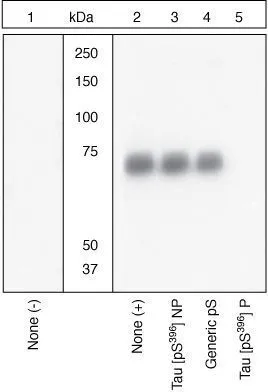
WB (peptide competition) analysis of human recombinant Tau treated with GSK-3 beta (1 microg per microg Tau) for 45 minutes (Lane 2-5) using GTX24858 Tau (phospho Ser396) antibody. The data shows that only the immunogen phospho peptide blocks the signal, demonstrating the specificity of the antibody. The primary antibody was prior incubated with peptide as following : Lane 1 : No peptide (Non-treated)) Lane 2 : No peptide (GSK-3 beta treated) Lane 3: The non-phospho peptide corresponding to immunogen Lane 4: A generic phosphoserine-containing peptide Lane 5: The phospho peptide immunogen
Tau (phospho Ser396) antibody
GTX24858
ApplicationsWestern Blot, ELISA, ImmunoHistoChemistry, ImmunoHistoChemistry Paraffin, Neutralisation/Blocking
Product group Antibodies
ReactivityBovine, Human, Mouse, Rat
TargetMAPT
Overview
- SupplierGeneTex
- Product NameTau (phospho Ser396) antibody - Orthogonal Validated
- Delivery Days Customer9
- Application Supplier NoteWB: 1:1000. *Optimal dilutions/concentrations should be determined by the researcher.Not tested in other applications.
- ApplicationsWestern Blot, ELISA, ImmunoHistoChemistry, ImmunoHistoChemistry Paraffin, Neutralisation/Blocking
- CertificationResearch Use Only
- ClonalityPolyclonal
- ConjugateUnconjugated
- Gene ID4137
- Target nameMAPT
- Target descriptionmicrotubule associated protein tau
- Target synonymsDDPAC; FTDP-17; G protein beta1/gamma2 subunit-interacting factor 1; MAPTL; microtubule-associated protein tau; MSTD; MTBT1; MTBT2; neurofibrillary tangle protein; paired helical filament-tau; PHF-tau; PPND; PPP1R103; protein phosphatase 1, regulatory subunit 103; TAU; tau-40
- HostRabbit
- IsotypeIgG
- Protein IDP10636
- Protein NameMicrotubule-associated protein tau
- Scientific DescriptionThis gene encodes the microtubule-associated protein tau (MAPT) whose transcript undergoes complex, regulated alternative splicing, giving rise to several mRNA species. MAPT transcripts are differentially expressed in the nervous system, depending on stage of neuronal maturation and neuron type. MAPT gene mutations have been associated with several neurodegenerative disorders such as Alzheimers disease, Picks disease, frontotemporal dementia, cortico-basal degeneration and progressive supranuclear palsy. [provided by RefSeq, Jul 2008]
- ReactivityBovine, Human, Mouse, Rat
- Storage Instruction-20°C or -80°C,2°C to 8°C
- UNSPSC12352203
References
- Protective Effect of Caffeic Acid against Alzheimers Disease Pathogenesis via Modulating Cerebral Insulin Signaling, beta-Amyloid Accumulation, and Synaptic Plasticity in Hyperinsulinemic Rats. Chang W et al., 2019 Jul 10, J Agric Food ChemRead more
- Changes in the Synaptic Proteome in Tauopathy and Rescue of Tau-Induced Synapse Loss by C1q Antibodies. Dejanovic B et al., 2018 Dec 19, NeuronRead more
